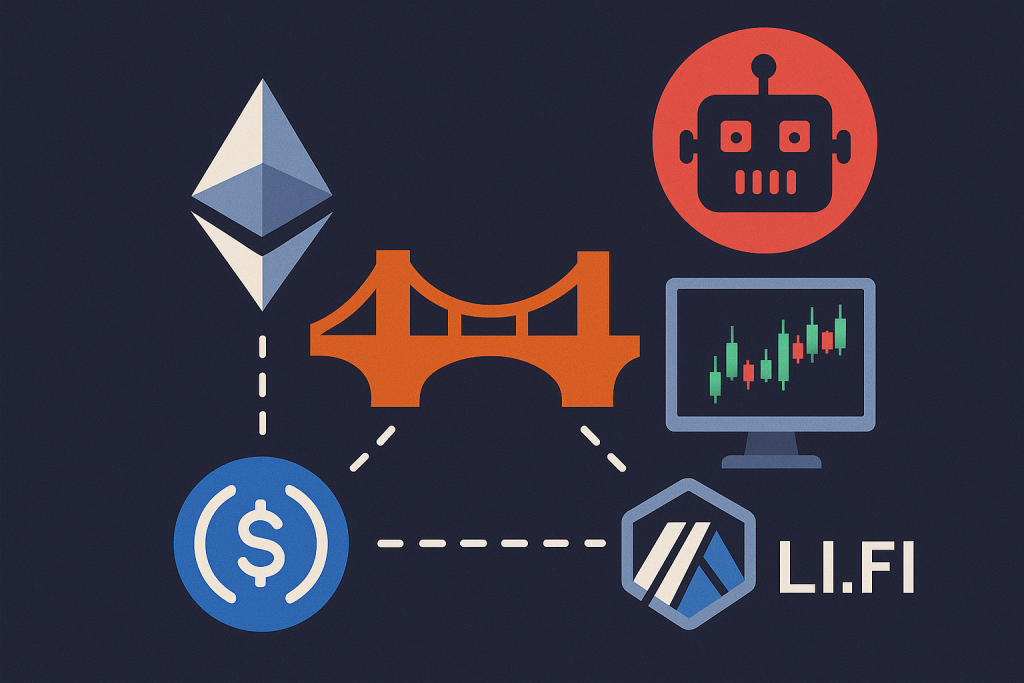Cross-chain trading has exploded over the past two years. More traders are jumping between Ethereum, Polygon, Arbitrum, and other networks to chase better yields or access specific protocols. But this blockchain-hopping comes with a hidden cost that many don’t see coming: MEV attacks.
MEV stands for Maximal Extractable Value – basically, it’s the profit that block builders and searchers can make by reordering your transactions.
Research from Flashbots and other MEV tracking services shows substantial value extraction from Ethereum users, with estimates reaching hundreds of millions of dollars over multi-year periods.
Platforms like the LI.FI website have started building tools to fight back, aggregating bridges and DEXs to give users better protection.
Why Cross-Chain Swaps Get Targeted
Here’s the thing about cross-chain transactions – they’re slow and predictable.
When you swap USDC from Ethereum to MATIC on Polygon, that transaction sits in the mempool for everyone to see. MEV bots scan these pending transactions constantly, looking for profitable opportunities.
The most common attack? Sandwich trades. A bot spots your $10,000 swap, quickly buys the token you want (driving up the price), lets your transaction execute at the worse price, then immediately sells back to you at a profit. It happens in seconds, and you might not even notice the extra slippage.
Cross-chain bridges make this worse because they often require multiple confirmations.
Your transaction might be visible for 10-15 minutes across different networks. That’s plenty of time for MEV operations to position themselves around your trade.
While comprehensive data on cross-chain MEV rates remains limited, industry observers note that multi-step transactions generally face higher extraction risks due to extended exposure windows.
How Modern Protection Actually Works
Private Mempools Cut the Problem at the Source
Private mempools solve the visibility issue directly. Instead of broadcasting your transaction to everyone, these systems (like MEV-protect RPCs) keep your trade details hidden until the block gets finalized. Flashbots pioneered this approach on Ethereum starting in 2020, and similar solutions now exist across multiple chains.
The catch? Performance varies wildly depending on which chain you’re using and how much validator adoption the service has. On Ethereum, private mempools work pretty well. On smaller chains, coverage can be spotty.
Order-flow auctions take a different angle. They route your transaction to competing block builders who bid against each other for the right to include it. Instead of losing value to MEV, you actually get some of that value back as a rebate. It’s like turning the MEV game in your favor, at least partially.
Protocol-Level Design Changes
Some newer protocols are building MEV protection directly into their architecture. The Symbiosis protocol uses synthetic tokens and a separate service chain to handle cross-chain swaps. By abstracting away the individual transaction steps, they reduce the windows where MEV extraction can happen.
Intent-based systems work similarly. Instead of specifying exactly how you want your trade executed, you just tell the system what you want to achieve. Specialized solvers then figure out the best path, often finding routes that minimize MEV exposure.
What the Numbers Actually Show
Measuring MEV impact isn’t straightforward, but researchers have developed some useful approaches. They typically run identical trades through different execution paths and compare the outcomes.
In bad market conditions – high volatility, low liquidity – unprotected cross-chain swaps can lose anywhere from a few basis points to several percentage points of their value. The exact amount depends on trade size, timing, and which tokens you’re swapping. With good protection and routing, these losses often drop significantly, though specific reduction rates vary by protocol and market conditions.
Several DeFi protocols have reported improvements after implementing MEV protection measures, though detailed public case studies remain limited. Common metrics include higher transaction success rates, reduced user complaints about poor execution, and measurably lower slippage on comparable trades.
Practical Steps That Actually Help
The most effective protection combines multiple approaches. First, use platforms that have built-in MEV protection – don’t rely on basic DEX interfaces that broadcast everything publicly.
Major aggregators like 1inch, Paraswap, and Matcha have implemented various protection mechanisms over the past two years.
Second, time your trades carefully. Network congestion often correlates with MEV activity, so trading during quieter periods can help. Tools like Ethereum gas trackers can give you a sense of when competition is lower.
Slippage settings matter more than most people realize. Setting tolerance too tight (under 0.3%) often causes failed transactions, especially for cross-chain swaps. But going too loose (over 2%) basically invites MEV extraction.
Most experienced traders stick between 0.5% and 1% for standard swaps.
Route selection makes a difference too. Aggregation protocols that actively monitor for MEV opportunities can route around known problem areas. They analyze dozens of potential paths and pick ones that balance speed, cost, and MEV risk.
Cross-chain MEV protection has moved from experimental to essential over the past year. Major blockchains now see substantial MEV activity – with various tracking services reporting billions in annual extraction across all chains combined.
As this grows, protection mechanisms are becoming standard infrastructure rather than nice-to-have features. Traders who understand and use these tools consistently report better execution and lower costs.



